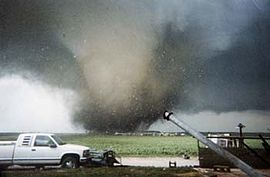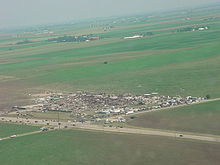2004 Roanoke tornado
On July 13, 2004, a powerful F4 tornado that formed outside of Roanoke, a small town in central Illinois. It is best known for the numerous videos and pictures taken of it as well as the complete destruction of the Parson's Manufacturing plant. Despite, the damage, there were only three minor injuries and no fatalities. It was one of six tornadoes to touch down on this day.
| F4 tornado | |
|---|---|
Part of the tornado outbreaks of 2004 | |
 Tornado hitting Parsons plant (Scott Smith via NWS) | |
| Formed | July 13, 2004 c. 2:30 pm CDT |
| Max. rating1 | F4 tornado |
| Casualties | 3 injuries |
| Areas affected | Roanoke, Illinois |
| 1Most severe tornado damage; see Fujita scale | |
Description
| FU | F0 | F1 | F2 | F3 | F4 | F5 | Total |
|---|---|---|---|---|---|---|---|
| 0 | 4 | 1 | 0 | 0 | 1 | 0 | 6 |
On Tuesday, July 13, 2004, at about 2:30 p.m., a tornado with a maximum reported width of a quarter mile (0.4 km) struck west of the village of Roanoke, damaging much of the area and cutting power to the main town of Roanoke for three days. It was later rated as an F4 on the Fujita scale. The tornado started approximately 1.8 miles (3 km) north of Metamora, located eight miles (12.8 km) west of Roanoke, and lifted approximately 2.5 miles (4 km) southeast of Roanoke. The tornado moved roughly southeasterly for a distance of 9.6 miles (15.4 kilometers) over about 25 minutes.
Damage

The worst damage occurred at the Parsons Company manufacturing plant, a parts supplier for Caterpillar Inc., which was leveled, losing its roof and outer walls. Although about 140 people were inside the building when the tornado struck, there were no fatalities and only a few minor injuries. This was attributed to preparations made during the construction of the plant and spotter training given to some of the workers. Although no tornado sirens were heard at the plant before the tornado struck, an alarm sounded by one of the spotters allowed all the workers to move to storm shelters and ride out the storm.
Large steel beams from the Parsons plant were blown approximately 3/4-mile (1.2 km) away, and many of the employees' cars tossed into nearby cornfields. Three neighboring farmsteads were completely swept away, with only debris remaining in the basements. Trees were debarked, and farm machinery was thrown and mangled. Based on the extreme damage, the tornado was classified as a violent F4 by the National Weather Service.
Video of the tornado
Two local residents chased the tornado for much of its 23-minute duration. They produced a half-hour-long video that was sold in the Peoria area to help raise funds for employees of the Parsons plant, most of whom had lost their cars and were either underinsured or not insured.
Impact
The storm was an example of how structural planning, storm spotting, and awareness techniques can be used by companies. The plant owner's decision to include storm shelters in the building's design likely saved the lives of many employees. Just as important, the early notice provided by the company storm-spotters allowed employees to reach the shelters before the storm struck. The Parsons plant reopened in April 2005 with seven tornado shelters, five more than the original plant.
The Roanoke tornado was the most significant tornado of a small tornado outbreak which transitioned into a destructive derecho over an extensive area of the Ohio and Tennessee Valleys extending to the Gulf of Mexico. The outbreak produced three other tornadoes, all rated F0. The Roanoke 2004 Tornado was featured on The Weather Channel's Storm Stories and Full Force Nature.
References
External links
- Roanoke F4 Tornado of July 13, 2004 (NWS Central Illinois)
- Supercell of July 13, 2004 (NWS Chicago)
- Preliminary Review of WSR-88D Radar Signatures seen in the F0 & F1 Central IL Tornadoes during the Record Setting 2003 Tornado Season (James Auten & Ernest Goetsch ~ NWS Central Illinois)
- The July 13, 2004 Tornado Event: Analysis of Tornadogenesis in a Highly Unstable Environment (Ed Shimon, Pat Bak & Kirk Huettl ~ NWS Central Illinois)
- The July 13, 2004 Tornado Event: The Contributions of Evolving Paradigms & Human Factors in the Warning Process (Lyle Barker ~ NWS Central Illinois)
- The July 13, 2004 Roanoke Illinois Tornado Event: The Warning Response Process at the Parsons Plant (Chris Miller ~ NWS Central Illinois)
- {https://web.archive.org/web/20110604123921/http://video.google.com/videoplay?docid=3669229307285179970&ei=_ZFvScGaEo3I-gGSnPm0BQ&q=roanoke,+il+tornado] Actual footage